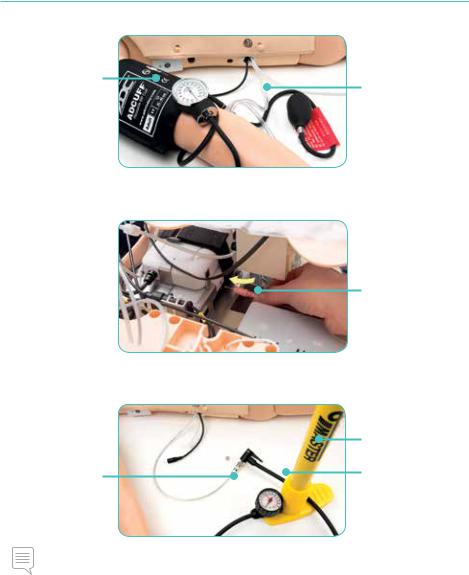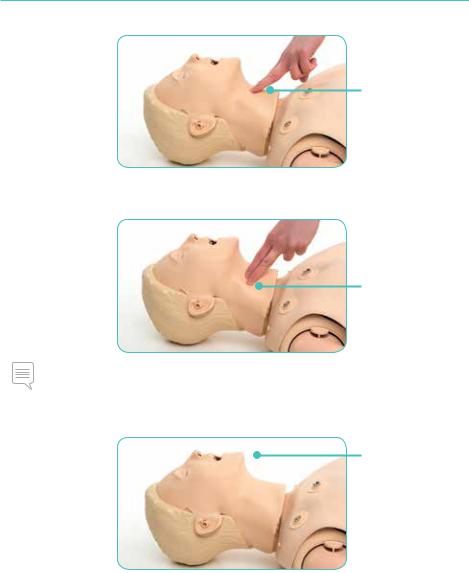Laerdal Resusci Anne Simulator User Manual [en, de, es, fr, it]

Resusci Anne Simulator
User Guide
English
www.laerdal.com

Resusci Anne Simulator
The Resusci Anne Simulator is a realistic manikin designed to meet the learning objectives of basic healthcare and intermediate life support. The simulator supports training for CPR, defibrillation, vital sign recognition and supraglottic airway management procedures.
––––––––––––––––––––––––––––––––––––––––––––––––––––––––––––––––––––––––––
Note
Photos/illustrations may vary from product.
2

Contents
1 |
Items included |
4 |
2 |
Get started |
6 |
3 |
Use |
10 |
4 |
Maintenance |
15 |
5 |
Cleaning |
20 |
See Important Product Information pamphlet for more information or visit www. laerdal.com
English
3

1 |
|
|
Items Included |
|
|
|
|
|
|
|
|
|
|
|
Airway Management Head |
|
|
|
|
|
Torso |
||
Blood Pressure Arm |
IV Arm |
|
Pelvis
Air Pump |
Blood Pressure (BP) Cuff |
SimPad (Link Box with lithium-ion |
|
|
battery installed in manikin). |
|
|
SimPad Wrist Strap and Sleeve |
Manual
Defibrillation
Plates
4

Items Included
English
Extrication
Rescue Legs
Pants
Full body soft pack
3 Eye Sets (normal, |
2 x AC Adapters |
USB Cable |
Simulated Blood Lubricant |
constricted, dilated pupils) |
|
|
|
5

2
Charge battery
Attach legs
Detach lower chest skin and fold back.
Remove bolt connector.
Get Started
Charge battery using
AC adapter included.
Remove stomach foam.
Twist to disconnect tubing between pelvis and torso.
Disengage pelvis from torso.
Do not disrupt connection wires between pelvis and torso.
6

Get Started
Remove Thigh Pad and insert bolt through hole in pelvis.
Slide washer and wing nut back over bolt.
Reattach pelvis, with legs, to torso.
Reconnect tubing between pelvis and torso and place in grove.
To remove legs, reverse procedure.
English
Remove wing nut and washer from bolt inserted in leg. Spring
assembly remains in leg.
Use screwdriver to secure screw while driving bolt into wing nut.
Replace bolt connector to secure.
Slide loose wires/tubes down into pelvis.
7

Get Started
Connect blood pressure cuff to arm
Place blood pressure cuff on arm.
Connect clear tubing on cuff to blood pressure connector on BP tubing. Insert connector and twist to click into place.
Connect external microphone (not included)
Plug microphone into jack on side of Link Box. Pink extension cable provided.
Fill air container
Attach air pump hose to fill valve located on right side of torso.
Air container is located inside pelvis.
Note
Use manual pump provided. Do not to exceed 10 bar (145 psi).
Detach air pump from fill valve.
If spontaneous breathing is activated and no chest rise is observed, ensure there is enough air in the air container. Refill as necessary.
8

Get Started
Prepare IV Arm
Select a vein and attach IV tubing to IV bag.
English
Allow fluid to flow through arm and out of other vein. Clamp off flow (with a knot or clamp) of fluid from open vein.
Connect SimPad to simulator
Refer to SimPad User Guide for instructions.
Connect PC to simulator (optional for SimPad Patient Monitor)
To use PC software, connect Ethernet cable between simulator and a computer. (Cable not included).
9

3 |
Use |
|
On/Off
On/Off button
Head tilt/Chin lift
Jaw thrust
Breathing
Spontaneous breathing is controlled by the SimPad.
10

Use
Ventilation
English
Airway management tools can be used.
Airway obstruction
Airway obstruction can be activated by the SimPad.
Note
•If the simulator is turned off while closure valve is closed, valve remains closed. Closure valve will open automatically when simulator is turned on.
•Do not use simulated vomit for suctioning.
Chest compressions
Manikin will detect correct hand position.
Note
Spontaneous breathing must be deactivated while performing CPR.
11

Use
Defibrillation
Defibrillation connectors and ECG connectors can be used with AEDs or manual defibrillators.
Note
Defibrillation must be performed on defibrillation connectors only. Observe safety precautions for use of defibrillators.
Caution
•Do not provide more than 2 x 360J discharges per minute on average to prevent overheating.
•Manikin chest must be kept dry. Ensure manikin remains dry when using IV arm.
•To prevent chest pitting, do not apply conductive gel or conductive defibrillation pads intended for patient use.
Lung
The simulator is equipped with one disposable unilateral lung.
Stomach
To deflate stomach, press gently.
12

Use
Heart and lung sounds
English
Heart and lung sounds are controlled by the SimPad.
Blood pressure
Right arm can be used for blood pressure training.
IV arm
Use left arm for IV training.
Note
If training session involves administration of fluids and/or drugs, empty arm immediately following session.
Pupils
Use different pupils to simulate various patient conditions.
13

Use
Cricoid cartilage
Cricoid cartilage can be detected.
Carotid pulses
Carotid pulses synchronize to ECG.
Note
Do not use excessive force when palpating the carotid pulse as this will result in no pulse felt.
Voice
Speaker in head emits prerecorded or live sounds. Refer to SimPad User Guide for instructions.
To run simulations
Refer to SimPad User Guide for information on how to control the simulator during sessions.
14

Maintenance
Pupil replacement
Pull back hair.
Detach the top of face skin and ears and fold back until eyes are exposed.
Detach eye from head. To insert new eye, place in hole and press into place.
Change battery
Only use Laerdal lithium-ion battery.
4 |
English |
Reattach face and hair by reversing procedure.
Release strap securing battery to Link Box.
15

Maintenance
Remove battery.
Detach battery connector from Link Box.
Secure battery Replace battery. with strap. Plug in battery
connector.
16

Maintenance
Ventilation
•Lubricate airway with two or three sprays prior to starting your training session.
•Lubricate airway management tools liberally prior to starting intubations. Consider whether additional lubrication is needed later in the session.
•Use only lubrication provided. Do not use silicon or other lubricant, as this may damage manikin.
Note
Head contains electrical components. Due to inability to sanitize airway, mouth-to-mouth/ mouth-to-mask ventilation should not be performed.
BP arm assembly and disassembly
For transportation using hard case you must disassemble BP arm.
Press grooves to release arm and expose cable.
Detach cable.
Remove arm.
To reassemble, reverse procedure. Ensure grooves on bolt fit properly into hole on torso. Reattach chest skin.
English
17

Maintenance
Lung replacement
Detach chest skin to expose lung.
Detach tubing from blue airway closure valve located under lung plate.
Reattach tubing to airway closure valve and attach new lung.
Press gently to secure lung plate.
18

Maintenance
Stomach replacement
Detach chest skin and lift lung plate to locate and easily access stomach tubing.
Breathing bladder replacement
Detach chest skin and locate breathing bladder under lung.
Detach breathing bladder and replace with new bladder.
English
Lift stomach piece.
Detach stomach bladder and tubing from stomach valve. Attach new stomach bladder.
Replace stomach piece. Reattach chest skin.
Reattach lung to lung plate.
Reattach chest skin.
19

5 |
Cleaning |
|
Preventive maintenance is the best method to ensure optimal operation. General inspection should be conducted at regular intervals.
Periodically wash all skin parts that are not regularly sanitized using warm water and soap or manikin wipes.
Most stains can be removed with warm water and soap or Laerdal manikin wipes. Before use, test cleaning agents on a non-critical area (e.g. under the chest cover).
Note
Pigments from lipstick and pens may be impossible to remove. Avoid using coloured plastic gloves when handling the manikin, as they may cause discolouration.
20

Resusci Anne Simulator
Gebruiksaanwijzing
Nederlands
www.laerdal.com

Resusci Anne Simulator
De Resusci Anne Simulator is een realistische oefenpop die ontworpen is om te voldoen aan de leerdoelen van reanimatie en EHBO. De simulator helpt bij het oefenen met reanimatie, defibrillatie, herkenning van vitale functies, en procedures voor luchtwegmanagement van de mond tot aan de stembanden.
––––––––––––––––––––––––––––––––––––––––––––––––––––––––––––––––––––––––––
N.B.
Foto's/illustraties kunnen per product verschillen.
22

Inhoud
1 |
Bijgeleverde onderdelen |
24 |
2 |
Aan de slag |
26 |
3 |
Gebruik |
30 |
4 |
Onderhoud |
35 |
5 |
Reiniging |
40 |
Raadpleeg de brochure met Belangrijke productinformatie voor meer informatie of ga naar www. laerdal.com
Nederlands
23

1 |
|
|
Bijgeleverde onderlen |
|
|
|
|
|
|
|
|
|
|
|
Luchtwegmanagement hoofd |
|
|
|
|
|
Torso |
||
Bloeddrukarm |
|
|
|
Infuusarm |
|
|
|
Bekken
Luchtpomp |
Bloeddrukmanchette |
SimPad (Link Box met lithium- |
|
|
ionbatterij, in de oefenpop |
|
|
geïnstalleerd). |
|
|
SimPad polsband en hoesje |
Defibconnectoren voor handmatige defibrillatie
24

Bijgeleverde onderlen (vervolg)
Nederlands
Articulaire ledematen die eventueel losgemaakt kunnen worden (bijv. bij beknelling)
Broek
Softpack waarin het volledige lichaam opgeborgen kan worden
Verwisselbare ogen met |
2 x AC-adapter |
Usb-kabel |
Simulatiebloed Lubrificant |
normale, vernauwde en |
|
|
|
verwijde pupillen |
|
|
|
25

2
Laad de batterij op
Bevestig de benen
Maak het onderste deel van de borstkas los en vouw het terug.
Verwijder de moerverbinding.
Aan de slag
Laad de batterij op met behulp van de bijgeleverde AC-adapter.
Verwijder het maagstuk (schuim).
Draai aan het koppelstuk om de slang tussen bekken en torso los te maken.
Schuif het bekken van de torso af.
Laat de bedrading tussen het bekken en torso vastzitten.
26

Aan de slag (vervolg)
Nederlands
Verwijder het klepje op de dij en steek de bout door het gat in het bekken.
Schuif het ringetje en de vleugelmoer terug over de bout.
Maak het bekken, met de benen, opnieuw aan de torso vast.
Maak de slangen d.m.v. het koppelstuk tussen het bekken en de torso opnieuw aan elkaar vast en plaats ze in de sleuf.
Volg de omgekeerde procedure om de benen te verwijderen.
Verwijder de vleugelmoer en het ringetje van de bout die in het been zit. De veer blijft in het been achter.
Gebruik eventueel een schroevendraaier om
de schroef stil te houden, terwijl de vleugelmoer op de bout wordt gedraaid.
Zet de moerverbinding terug om het bekken vast te zetten.
Schuif losse draden/ slangen naar beneden in het bekken.
27

Aan de slagAan(vervolg)de slag
Plaats de bloeddrukmetermanchette om de arm
Plaats de bloeddrukmetermanchette
om de arm.
Koppel de doorzichtige slang van de manchette via de connector aan de bloeddrukmeetslang.
Steek het verbindingsstuk erin en klik het vast door te draaien.
Sluit, indien gewenst, de externe microfoon aan (niet bijgeleverd)
Steek de stekker van de microfoon in de
contactbus aan de zijkant van de Link Box. Er is een roze verlengsnoer bijgeleverd.
Vul de luchttank
Verbind de slang van de pomp aan het vulventiel dat zich aan de rechterzijde van de torso bevindt.
De luchttank bevindt zich in het bekken.
N.B.
Gebruik de bijgeleverde handpomp. Blijf onder de 10 bar (145 psi).
Maak de luchtpomp los van het vulventiel.
Indien de spontane ademhaling is geactiveerd en de borstkas niet omhoog komt, kijk dan of er voldoende lucht in de luchttank zit.Vul zo nodig bij.
28

Aan de slag (vervolg)
Bereid de infuusarm voor
Kies een bloedvat uit en bevestig de infuusslang hieraan.
Nederlands
Laat vloeistof door het gesimuleerde bloedvatensysteem stromen. Klem de vloeistofstroom (met een knoop of klem) van het open bloedvat af.
Sluit de SimPad op de simulator aan
Raadpleeg de SimPad-gebruikershandleiding voor instructies.
Sluit de PC op de simulator aan (optioneel voor de Simpad patiëntmonitor)
Gebruik een ethernetkabel om de simulator op een computer aan te sluiten. (Kabel niet bijgeleverd).
29

3 |
Gebruik |
|
Aan/Uit
Aan-/Uitknop
Hoofd naar achteren kantelen/kin omhoog
Mond openen via kaakgewricht (jawtrust)
Ademen
De spontane ademhaling wordt door de SimPad geregeld.
30
